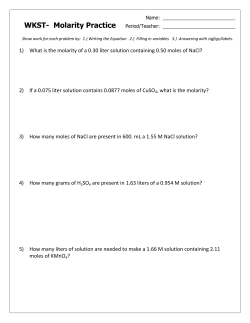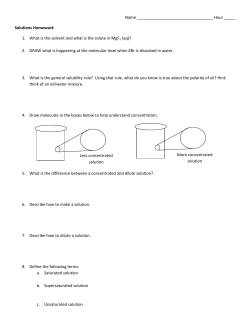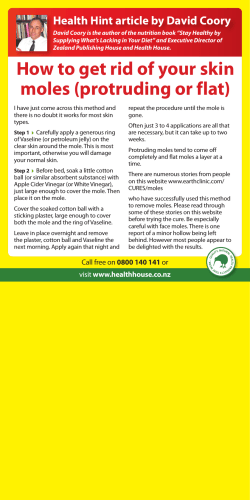
1. Which of these ratios are `ONE`? In the box below e
Review #1 Name_____________ CλeMis+ry: http://genest.weebly.com Period_____________ Stop in for help every day at lunch and Tues &Thurs after school! Checklist for this Friday’s test: By the time we finish this unit, you should be able to: Relate the molar concentration (molarity) of a solution to the number of moles and volume of the solution. Beginning with a balanced equation and the volume and molarity of a reactant or product, predict the moles of another reactant or product in the reaction. Describe endothermic and exothermic reaction in terms of • energy bar graphs and system flow diagrams (LOLOL) • Balanced equations with a quantitative energy term • H notation Solve stoichiometry story problems. Know the conversion factors for these: • volume of a gas • volume of a solution, or • energy of reaction And use these to determine stoichiometric relationships in a chemical reaction story problem Vocabulary • Concentration • Molarity • Molarity • Endo-, exothermic • Enthalpy Review Concepts: • Solutions: a homogeneous mixture of a solute dissolved in a solvent; dissolving process • Energy storage and transfer mechanisms in a molecular system; Energy constants 1. Which of these ratios are 'ONE'? In the box below each if the factor is true write True! if the factor is incorrect rewrite it so it isn't. 1 𝑦𝑒𝑎𝑟 365.25 𝑑𝑎𝑦𝑠 22.4 𝑚𝑜𝑙𝑒𝑠 𝐴𝑟 𝑔𝑎𝑠 1 𝑚𝑜𝑙𝑒 𝐴𝑟 6 𝑝𝑙𝑎𝑦𝑒𝑟𝑠 2 𝑏𝑎𝑠𝑒𝑏𝑎𝑙𝑙 𝑡𝑒𝑎𝑚𝑠 1 𝑖𝑛𝑐ℎ 12 𝑓𝑒𝑒𝑡 1 𝑔𝑟𝑎𝑚 𝑐𝑜𝑝𝑝𝑒𝑟 ∗ 6.02𝑥1023 𝑎𝑡𝑜𝑚𝑠 𝑜𝑓 𝑐𝑜𝑝𝑝𝑒𝑟 2. This is a solid chunk of sodium carbonate. In the box draw an aqueous chunk of the same substance. Include eight water molecules. Make sure the waters are pointing in the right direction! 3. 4. Which end of H2O has which electrical charge? Circle a correct choice in each parenthetical pair. 5. If two objects are electrically both positive, those objects will ( repel / attract ). 6. Opposite charges ( attract / repel ). 7. Things are facing in the wrong directions here. Think about ‘opposites attract’ and draw things facing correctly in the box. 8. From memory, what is the formula of each carbonic acid _________________ phosphoric acid_______________ 9. Natural gas contains 97% methane (CH4), 1.5% ethane (C2H6), 1% CO2, and 0.5% nitrogen gases. solvent ______________________ solute(s): 10. Things are facing in the wrong directions here. Think about ‘opposites attract’ and draw things facing correctly in the box. 11. Suppose an excess of aluminum was allowed to react with 45 mL of aqueous 0.39M hydrochloric acid to produce aluminum chloride and hydrogen gas. Assume the acid is the limiting reactant. a. Write a balanced equation. b. If all of the acid reacts, how many moles of aluminum should react? c. If all of the acid reacts, how many grams of aluminum chloride will form? d. If all of the acid reacts, how many liters, at STP, of hydrogen should form? Directions: Turn the following into balanced equations by filling in the blanks with the correct coefficients, formulas of ions or solids, and names. Cation 12. _____ + Anion _______ 13. ______ + _______ Formula Name BaI2 _____________________ _________ iron (III) sulfide 14. You need to find the limiting reactant at some point to solve this one: Determine the volume in liters of carbon dioxide that should be produced in the reaction between 98.0. g of carbon and 500. liters of O2. (Similar to the scissors sheet) 15. What is the formula for finding volume if you’re given moles and concentration?
© Copyright 2025

















